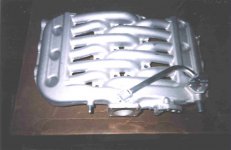While it may be cheaper to produce, the oval port design is much better than it's predocessor.
What criteria are you basing this call on? Power output? Cost? Manufacturing? Torque output? weight?
The velocity profile is much better with oval ports
What velocity profile? Across the port at a given rpm? Maybe at one fixed engine rpm it might be better, but I guarantee the split port will show better velocity in much more of the rpm band than the oval port, all while providing a greater total flow capacity.
as well as better combustion efficency since the fuel is dispersed between two valves instead of one.
How do you figure? I don't recall ever seeing anyone have issues with combustion efficiency in any of the split port engines. Even if the oval port is slightly better here, its an academic point, since the difference isn't great enough to significantly affect the engine performance. The only thing you can say for certainty regarding injectors for each port style, is that you should be using the appropriate injector spray pattern for each one. A single spray pattern for the split port, and a two spray pattern for the oval port so all the fuel doesn't end up on the bridge between the valves. FWIW, it is FAR easier to find a single spray pattern injector in larger than stock sizes than it is to find the split pattern ones . . .
This has been the norm for many years. Prostock has moved to oval ports. F1 has used the oval design for years as well as many OEM's abroad.
Apples and oranges much? An 18k rpm F1 engine obviously has EXACTLY the same design considerations as our 6800rpm duratecs . . . F1 engines idle near our redline rpms . . . They are simply after port area, it would be more like taking the larger spread of the split port head and milling out everything in between the two ports to make as much area as possible. Not exactly the best thing for low rpm velocity and cylinder filling.
I'm sick of the blind bandwagon gang on this one. The oval port manifolds are good designs within thier design envelope, and they have had decent amount of development (and Ford isn't done with them either . . .) but they really were implemented just to save money (trust me, I've asked some of the guys that actually did the design work). This cheaper oval port design was optimized for the applications it was to be used in, which is a mid-size sedan or small SUV attached to an auto trans, which means solid mid-low range torque at the expense of peak power. If this is what you are looking for, then yes, by all means this is the best design for you. The ST220 wanted to be optimized a little better for peak hp, while compromising as little as possible in the mid-low range of torque, which is how it ended up with shorter but more tapered runners.
And in regards to the Porsche manifold on the early development 2.5L engines, I'm not convinced the manifold really had much to do with the difference in power output. I believe it had more to do with cam profiles and calibration, and other extensive differences in the engine than the intake manifold plenums. In fact, I think that the Porsche design just may have hindered high rpm flow in the short runners with the placement of the plug wire holes. Look at the pic again, and see how they shroud much of the entry area for each of the short runners. Further, the plenums are flatter and extend further away from the ports rather than being larger around the runner entry points. Hardly showstopping, but not perfectly ideal either. Further, the larger plenum, plus the plug access holes would wreak havoc on any helmholtz tuning, as the pressure waves would never reflect back to thier original ports.
All of the duratec manifold designs are actually pretty good when considered with thier original design compromises, and for us, as enthusiasts, about the worst thing we could do is put a split port manifold over the top of an oval port head without keeping the flow divided all the way down to the valves; And even that really isn't that bad as shown by the number of people on here that have done it in order to make the 3L swap easier for them to manage. Even these engines make good power and torque across the rev range.
All this straining back and forth over what amounts to relatively minor variations in performance; the kind where you'd really have to run a number of each style to get a statistically significant sample to really understand exactly what the real differences are where they aren't clouded by outside factors such as dyno to dyno variation, driveline losses variation, tire pressure variation, etc. etc.

